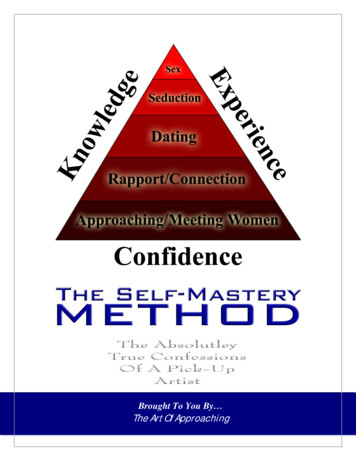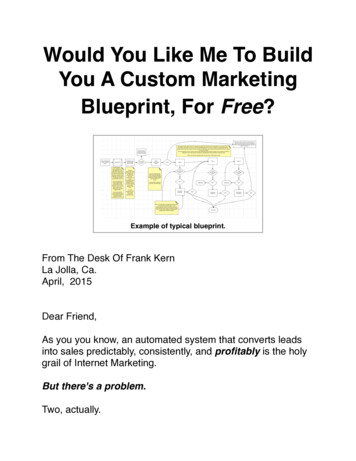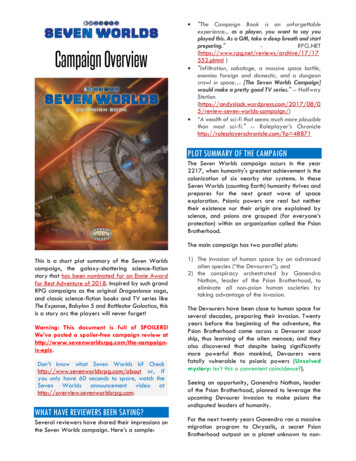
Transcription
Brought to you by
Conversational Intelligence Judith GlaserConversational Intelligence: How Leaders Build Trust and Get Extraordinary ResultsBibliomotion: Brookline, MA, 2013. 256 pages.Conversations are not what we think they are. We’ve grown up thinkingthey are about talking, sharing, information, telling people what to do,or telling others what’s on our minds. We are now learning, throughneurological and cognitive research, that a “conversation” goes deeper andis more robust than simple information.Conversations are dynamic, interactive, and inclusive. They evolve and impact the way we connect,engage, interact, and influence others, enabling us to shape reality, mind-sets, events, and outcomesin a collaborative way.In Conversational Intelligence, author Judith E. Glaser translates the wealth of new insights comingout of neuroscience from across the globe, and brings the science down to earth so people canunderstand and apply it in their everyday lives. The book contains a framework for knowing whatkind of conversations trigger the lower, more primitive brain; and what activates higher-levelintelligences such as trust, integrity, empathy, and good judgment.The premise of Conversational Intelligence is: To get to the next level of greatness depends on thequality of our culture, which depends on the quality of our relationships, which depends on thequality of our conversations. Everything happens through conversations.1Part One: Defining Conversational Intelligence and Why We Need ItWhat Can We Learn from Our Worst ConversationsConversations are multidimensional, not linear. What we think, what we say, what wemean, what others hear, and how we feel about it afterward are the key dimensionsbehind Conversational Intelligence. Thoughconversations are not simply “ask and tell”levels of discourse, we often treat them asthough they are.Conversations are the golden threads, albeitsometimes-fragile ones that keep us connectedto others. Human beings have hardwiredsystems exquisitely designed to let us knowwhere we stand with others; based on a quickread of a situation, our brains know whetherwe should operate in a protective mode or beopen to sharing, discovery, and influence.When we are out to win at all costs, we operateout of the part of the primitive brain called theamygdala. This part is hardwired with the welldeveloped instincts of fight, flight, freeze, orSums and the Vision Room are resources powered by Auxano.1
Conversational Intelligence Judith Glaser (cont’d)appease. When we feel threatened, the amygdala activates the immediate impulses that ensure wesurvive. Our brains lock down and we are no longer open to influence.On the other side of the brain spectrum is the prefrontal cortex. This is the newest brain, and itenables us to build societies, have good judgment, be strategic, handle difficult conversations, andbuild and sustain trust. Yet when the amygdala picks up a threat, our conversations are subject to thelockdown, and we get more “stuck” in our point of view.Protecting ourselves is hardwired in our brains. Fear and conflict not only change the chemistry of thebrain, they also change how we feel, how we behave, and how others perceive us. In a nanosecondwe can move from being seen as a trusted friend and advisor to being seen as a frightening threat,a person deeply distrusted, because fear has tipped the scales that way.Worse yet, when the amygdala goes into overdrive, it activates the limbic area of the brain, whichstores all of our old memories. Once triggered, this part of the brain begins to remember othersimilar hurts and threats, and lumps them together into a “movie” that we unconsciously replay.Without our even realizing it, the moviemaking mind can take old memories and edit them into anew scary movie, giving our current situation a meaning for us that our bosses and colleagues andemployees might see very differently. Trust is difficult to sustain when we build a rich inner world ofdrama that we do not share with those around us. Put another way, trust is difficult to sustain whenwe are afraid to share our inner world; that’s the only way to close the gap between what we’rethinking and what others are thinking about what’s real, not to mention what’s smart, right, and fair.Conversations are the social rituals that hold us together, the fabric of culture and society. Sometimeswhen we as leaders are marching forward, furiously achieving our goals and objectives, we fail tosee the impact of the minute, yet powerful interactions in conversations on others. Yet once we do,we can change the interaction dynamics and change our future forever.When We Lose Trust, We Lose Our VoiceBeing in sync with others is vital to healthy relationships. And it’s not just a metaphor. Researchindicates that when we are comfortable with someone, our heartbeat becomes more coherent,sending signals to the brain to relax, open up, and share with that person. When gaps arise betweenwhat we expect and what we get, we become uncertain of our relationship and our fear networksbegin to take control of our brains.As a result, we find ourselves lacking the neurochemical and hormonal support for placing trust inothers. Our good judgment gives way to defensive aggressive, or passive-aggressive behaviors thathave a huge impact on our ability to be effective at our jobs. Our challenge, therefore, is to find waysto head off our fears, or, at the very least, understand where they may be coming from so we canwork backward to find a solution.Moving from Distrust to TrustWhen we are in a fear state, our conversations are shaped by the neurochemistry of fear.We can only thinkabout protecting ourselves.The best antidotes to the brain’s fear state are trust, empathy, and support.Sums and the Vision Room are resources powered by Auxano.2
Conversational Intelligence Judith Glaser (cont’d)2Part Two: Raising Your Conversational IntelligenceConversations are rituals we embed into our culture and our relationships, and whichgive us a way to successfully structure our engagements with others. Part II focuses onwhat you can do to shape conversations for success.Breakdowns happen when you and I think we are talking to each other but we arereally talking past each other. We are so engrossed in what we have to say that we don’t realizewe are carrying on our own monologues, not dialogues. When we are conversationally blind, ourconversations often go off track because we see the world from our own perspective and not fromother person’s.Level Setting ConversationsHow do we become more conversationally intelligent? One way tounderstand how to level set our conversations.The following conversational tool, called the Conversational Intelligence Matrix, enables you torecognize the quality of your interaction dynamics, the level of trust you and others are operating with,and the outcomes produced by each level of conversation. As you learn to use the ConversationalIntelligence Matrix, you can begin to eliminate Conversational Intelligence blind spots and engagein healthy conversations at Levels I, II, and III.What Do We Exchange?ConversationalIntelligence TRANSFORMATIONAL“Exchange Information”“Exchange Power”“Exchange Energy”Interaction DynamicsSpaceFocusAsk-TellCloses SpacesCONFIRM what you knowGiving and taking informationAdvocate-InquireLimits SpaceDEFEND what you knowExploring others’ positions seeking awin-win solutionBlindspots & Overuse“Tell-Sell-Yell Syndrome”Tendency toward telling morethan asking“Addicted to Being Right”Tendency to ask questions for whichyou have all the lls to DevelopINFORMTo protectI-centricMy successLow trustNot open to influenceAbility to ask open ended questionsand foster ‘give and take’PERSUADETo accept or rejectI & We-centricWin at all costConditional trustDesire to influenceAbility to share the conversationalspace with others; expand powerShare-DiscoverCreates SpaceEXPLORING what you don’t knowExploring others’ perspectives;joining with others to transformreality; innovating; co-creating“All Talk No Action”Tendency for too much talkand no actionC0- ‐CREATETo connectWE-centricMutual successHigh trustOpen to influenceAbility to ask questions for whichyou have no answers; co-creating eSums and the Vision Room are resources powered by Auxano.3
Conversational Intelligence Judith Glaser (cont’d)Level I: TransactionalConversations can be categorized as “Tell and Ask” interactions dynamics. People are exchanginginformation, updates, and facts that help us align our realities or confirm we are on the samepage. There is not a lot of trust, and people are focusing more on what they need to get from eachother to validate and confirm their view of reality.Level II: PositionalThese conversations are characterized by “Advocate and Inquire” interaction dynamics. In a Level IIconversation I am advocating for what I want and I am inquiring about your beliefs so I can influenceyou to my point of view. However, if I feel that you are not going to be fair or are lobbying at myexpense, I will retreat into protective behaviors.Level III: TransformationalTransformation conversations are marked by “Share and Discover” interaction dynamics. When Ishare first, my brain receives a cue that I will be vulnerable with you and that I will open up my innerthoughts, ideas, and feelings. Others in the conversation receive the signal that you are willing to beinfluenced, that you are about them, and that they can trust you to experiment and innovate with them.To raise your Conversational Intelligence, you need to become master and co-creator of conversationalrituals that enable the greatest expression of ideas, feelings, hunches, thoughts, and aspirations possible.Sums and the Vision Room are resources powered by Auxano.4
Conversational Intelligence Judith Glaser (cont’d)Priming for Level III ConversationsThe best communicators learn to align their intentions with their impact. While intention is whatsomeone wants to make happen or plans to accomplish, the impact involves the quality of theexperience from the perspective of the receiver – and that impact may not correspond with what thecommunicator intended.3 Part Three: Pulling It All TogetherTo help you elevate your culture to Level III interaction dynamics, start engaging in theseven vital conversations outlined below. Each one facilitates your ability to accessConversational Intelligence and to enhance your powerful ability to co-create with others.Co-creating Conversations – catalyze functions in the prefrontal cortex that stimulate mirror neurons,which enable you to see the world through others’ eyesHumanizing Conversations – catalyze functions in the prefrontal cortex that stimulate higher levels ofempathy and candorNavigating Conversations – catalyze functions in the prefrontal cortex that stimulate higher levelsof collaborationGenerating Conversations – catalyze functions in the prefrontal cortex that stimulate learningfrom mistakesExpressing Conversations – catalyze functions in the prefrontal cortex that stimulate higher levels ofjudgment and voiceSynchronizing Conversations – catalyze functions in the prefrontal cortex that enable you toclose the gaps between reality and aspirationsAsk yourself: What CHANGES are you willing to make to elevate yourculture to Level III?The keys to successful change lie in understanding change from a Conversational Intelligenceperspective. Change is more a process that “we” do together than “I” do alone. When leaders honorand respect how our WE-centric brains respond to change, they will become champions of a new levelof leadership fueled by applying all three levels of Conversational Intelligence at the right time and inthe right way.Conversational Intelligence gives us tools for letting go of the past andtransforming the future.Everyone can become a master of Conversational Intelligence. It teaches us to see differently – to listendifferently – and to process what we perceive differently. When we do that, we act in the moment inways that create energy, activate energy, and help guide energy toward more productive and morepowerful ends.Adapted with permission from Conversational Intelligence: How Great Leaders Build Trust and GetExtraordinary Results by Judith E. Glaser (Bibliomotion, October 2013).Sums and the Vision Room are resources powered by Auxano.5
Conversational Intelligence Judith Glaser (cont’d)Recommended Resources1. Read what Auxano Founder and Team Leader Will Mancini has to say about the “invisible walls”that often keep your ministry team from working together – walls that can often be broken downwith intentional conversations.2. Read about the power of conversations from author Judith E. Glaser.3. Have you found yourself in a situation of escalating conversations, maybe even an argumentduring a staff meeting? Read why author Judith E. Glaser thinks your brain has been “hijacked.”4. Understand the Three Dimensions of conversation in this article by Conversational Intelligenceauthor Judith E. Glaser.Amazon Linkshardcover linkReceive a new SUMS deliveredto your Inbox every other weekSums and the Vision Room are resources powered by Auxano.6
Go Ahead Actions for Vision Clarityby Mike GammillVision Clarity ConnectionJudith Glaser’s Conversational Intelligence can help take your leadership to the next level by showingyou how to increase the quality of your conversations. Moving from conversations from the amygdala(fight, flight, freeze, or appease) to the prefrontal cortex (share, discover, partner) can make the differencebetween the relational distrust that can sabotage productivity and the corporate trust that can generatenew horizons of productivity.Go Ahead1. Use Conversational Redirecting to help your team move from a stagnant ministry practice to a placewhere it can see new opportunities. First, identify a ministry area that could benefit from a fresh perspective. Second, create a temporary micro-team tasked with researching the ministry practices of threeother churches, selecting one to learn from in a first-hand ministry observation and creating a reportthat includes the best of what was learned and new opportunities for that ministry area. Third, invest 30 minutes in a key staff meeting to discuss how to best implement the discovery fromthe team.2. Use Double Clicking to help team members understand one another, empathize with each other, andminimize unnecessary conflict. Divide your selected team into groups of 3-5 individuals for a group sharing exercise. First, give each individual a piece of paper. Ask each person to draw a large circle on his paper withthe word “success” written into its center. Next, have them draw twelve spokes around the circle sothat it looks like a clock. Ask each participant to write one word on each spoke that represents what“success” means to him. Next, ask people to share with other in their small group the twelve ideas that represent success to them. Finally, move back to a larger group discussion and allow individuals to share what they learnedabout each other’s motivations, dreams, and values.3. Develop your team’s conversational intelligence checking the Five Conversational Blind Spots in teaminteractions and decisions. First, review and discuss five conversational blind spots for understanding. Second, develop into team self-awareness and identify a time when a team member intuitivelychecked one of these blind spots during a recent interaction. Likewise, identify a blind spot that theteam is prone to miss. Finally, discuss, as a team, ways to effectively address the Five Conversational Blind Spots in teaminteractions and decisions.Sums and the Vision Room are resources powered by Auxano.7
More About Mike GammillAs Lead Navigator for Auxano, Mike Gammill is passionate about using VisionClarity to help the local church find its unique place in the Kingdom of God. Mikehas fifteen years of experience serving the local church in multiple capacitiesand has a demonstrated ability to walk alongside pastors and leaders to uncoverinnovative ways to strategically implement vision through Christ-like leadership.Email: mike@auxano.comTwitter: @mikegammillBlog: mikegammill.comPhone: 406.219.1104Bio: Read MoreSums and the Vision Room are resources powered by Auxano.8
Auxano is the only vision clarity consulting group that will guideyour team through a God-ward and collaborative process called theVision Pathway. To learn more, visit auxano.com or check us out onTwitter and our Auxano and VisionRoom Facebook pages.Receive a new SUMS deliveredto your Inbox every other weekauxano.comSums and the Vision Room are resources powered by Auxano.
Conversations are rituals we embed into our culture and our relationships, and which give us a way to successfully structure our engagements with others. Part II focuses on what you can do to shape conversations for success. Breakdowns happen whe











